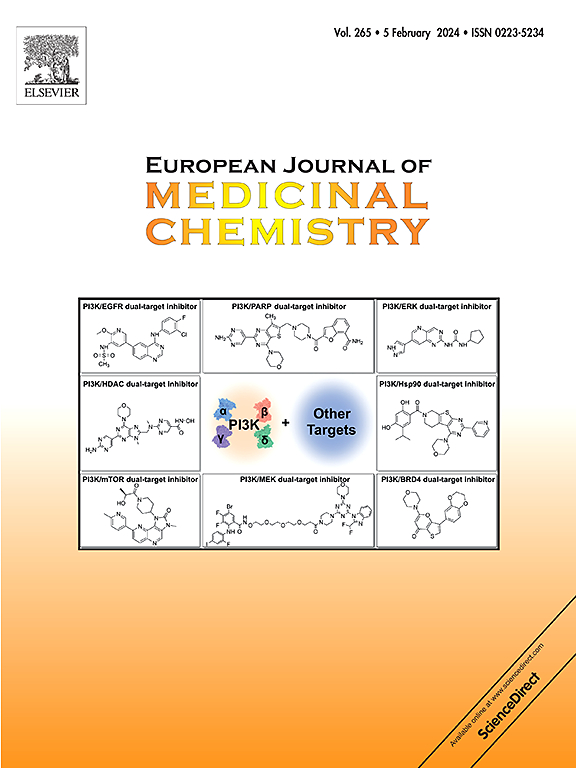恶唑烷酮作为抗万古霉素耐药肠球菌碳酸酐酶抑制剂的重新设计。
IF 6
2区 医学
Q1 CHEMISTRY, MEDICINAL
引用次数: 0
摘要
万古霉素耐药肠球菌(VRE)作为医院获得性感染的主要原因的增加强调了迫切需要新的治疗策略。事实上,耐药性不仅对万古霉素产生,而且对其他临床使用的药物,如达托霉素和利奈唑胺也产生了耐药性。我们提出了一种新的药物设计方法,将二代恶唑烷酮(tedizolid)与碳酸酐酶抑制剂(CAIs)结合起来,后者在临床中被用作未经批准的补助性治疗。这些磺胺衍生物对粪肠球菌碳酸酐酶有较强的抑制作用,对EfCAα和EfCAγ的KI值分别为14.6 ~ 598 nM和63.2 ~ 798 nM。计算模拟阐明了这些双作用抗生素与50S核糖体亚基肽基转移酶中心(PTC)和细菌CAs的结合模式。六种衍生物的一个子集显示出与ptc相关的有效抗肠球菌作用,其中一些化合物的效果优于恶唑烷酮和CA抑制剂药物(MIC值在1至4 μg/mL范围内)。本文章由计算机程序翻译,如有差异,请以英文原文为准。


Redesigning oxazolidinones as carbonic anhydrase inhibitors against vancomycin-resistant enterococci
The rise of vancomycin-resistant enterococci (VRE) as a leading cause of hospital-acquired infections underscores the urgent need for new treatment strategies. In fact, resistance has developed not only to vancomycin but also to other clinically used agents, such as daptomycin and linezolid. We propose a novel drug design approach merging tedizolid, a second-generation oxazolidinone used as an unapproved salvage therapy in clinical settings, with carbonic anhydrase inhibitors (CAIs) recently validated as functioning decolonization agents. These sulfonamide derivatives showed potent inhibition of the carbonic anhydrases from Enterococcus faecium, with KI values in the range of 14.6–598 nM and 63.2–798 nM against EfCAα and EfCAγ. Computational simulations elucidated the binding mode of these dual-action antibiotics to the peptidyl transferase center (PTC) of the 50S ribosome subunit and bacterial CAs. A subset of six derivatives showed potent PTC-related anti-enterococcal effects against multidrug-resistant E. faecalis and E. faecium strains with some compounds outperforming both the oxazolidinone and CA inhibitor drugs (MIC values in the range 1–4 μg/mL).
求助全文
通过发布文献求助,成功后即可免费获取论文全文。
去求助
来源期刊
CiteScore
11.70
自引率
9.00%
发文量
863
审稿时长
29 days
期刊介绍:
The European Journal of Medicinal Chemistry is a global journal that publishes studies on all aspects of medicinal chemistry. It provides a medium for publication of original papers and also welcomes critical review papers.
A typical paper would report on the organic synthesis, characterization and pharmacological evaluation of compounds. Other topics of interest are drug design, QSAR, molecular modeling, drug-receptor interactions, molecular aspects of drug metabolism, prodrug synthesis and drug targeting. The journal expects manuscripts to present the rational for a study, provide insight into the design of compounds or understanding of mechanism, or clarify the targets.

 求助内容:
求助内容: 应助结果提醒方式:
应助结果提醒方式:


